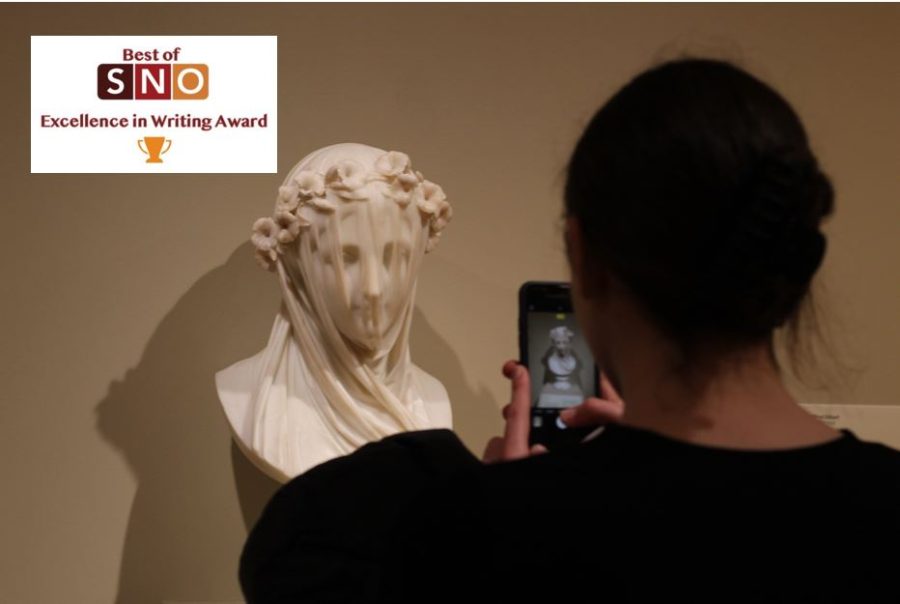A rare glimpse
Cannon Falls High School’s Humanities students got the unique opportunity to view Renaissance pieces on loan to the Minneapolis Institute of Art in a once-in-a-lifetime exhibit.
CFHS Humanities students adored The Veiled Lady by Raffaelle Monti for its demure expression and expertly carved features.
The opaque automatic door slid open. Not knowing quite what to expect, a gaggle of students stepped into an expansive room, adorned with beautiful paintings and statues on all sides. As they walked in, their eyes were immediately drawn straight ahead from the door to a colossal portrayal of a centaur having his hair tugged by the beautiful goddess Pallas Athena, who has a loose grip on an axe. The painting is Pallas and the Centaur, by the renowned Italian artist Sandro Botticelli.
Pallas and the Centaur, one among others of Botticelli’s work and other prominent art pieces from the Renaissance have made a rare venture outside of their home at the Uffizi gallery in Florence, Italy. Eike Schmidt, the director at the Uffizi gallery, was a former curator at the Minnesota Institute of Art (MIA) and collaborated closely with the MIA to bring the Botticelli and Renaissance Florence: Masterworks from the Uffizi exhibit to fruition in Minneapolis as a once-in-a-lifetime experience. Because the MIA was entrusted with these pieces, it is a significant source of pride for Minnesotans to have them displayed in Minneapolis as the only location in the United States that has ever held this Botticelli Uffizi exhibit. The exhibit is composed of works from the Uffizi, the MIA, and private collections to create a comprehensive view of the Renaissance, including some works that had never touched the United States before the MIA hosted them.
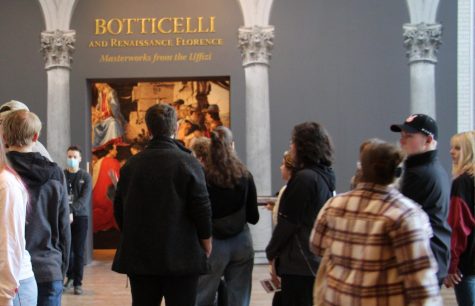
On Friday, January 6, Cannon Falls High School’s Humanities students visited the MIA both as an opportunity to venture through the limited-time Botticelli and Renaissance Florence: Masterworks from the Uffizi featured gallery and the other exhibits available perpetually to guests. As the Humanities course focuses on the nuances of specific cultures, teachers Nicolette Hernke and Holly Winget compared the art forms from class to the exhibits at the MIA to emphasize the real-life applications of art, both here in Minnesota and abroad. Winget stated: “Everyone needs to experience art in the wild — see the actual piece — not a reproduction [and] to appreciate [it]: scale, brushstrokes, medium, how art lasts, [and] what makes something valuable, or ‘museum-worthy.’”
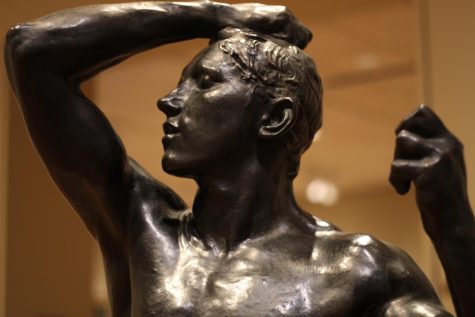
Developed and cultivated by English teacher John Fogarty and art teacher Dennis Kalow in the early 1980s, Humanities is a unique class offered by Cannon Falls High School. The course always has two teachers – from the English and art departments – and follows a wide array of subjects but stresses art, history, literature, architecture, philosophy, anthropology, and religion. One of their upcoming units in their second semester will focus on the Renaissance, and ultimately, Botticelli’s influence.
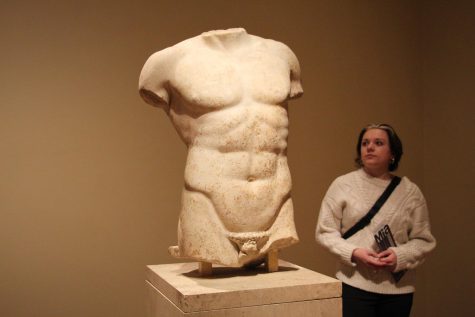
While at the MIA, the students made a pit stop on the way to the Renaissance exhibit in a room featuring Greek and Hellenistic pieces. Right before their winter break at the end of December, their Greece and Hellenism unit had been wrapped up, so the artistic styles and techniques used during these eras were fresh on the students’ minds.
Hernke reiterated how these pieces differed from each other and how technique improved over hundreds of years. From the early era of Greece, there was an Archaic statue, with its staple “cheesy” Archaic smile, almond-shaped eyes, and very little evidence of limbs under its clothing. In stark contrast, upon a pedestal in the center of the room, there was a classical statue, featuring a contrapposto stance and a more naturalistic pose. “The Greek room was one of my favorite parts of the whole trip. Even though my teachers have preached about the realism of Greek art, it’s not something I understood until I actually saw it,” junior Humanities student Sara Auger said.
There were also pottery pieces in glass display cases, with examples of both red and black figure pottery, another of the major parts of Hernke’s section of the Greek unit. Auger continued, “I loved being immersed in the art we had been studying; it’s always so gratifying to see something you’ve studied out in the real world.”
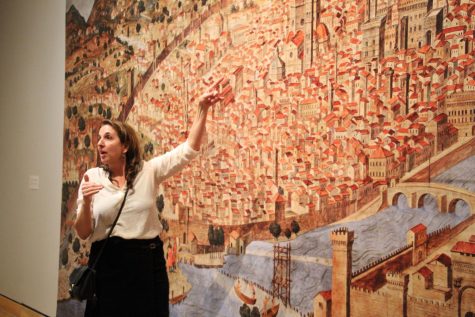
The main attraction of the day was the Botticelli exhibit. It contained an amalgamation of pieces from various artists, but all were centered on the Renaissance era.
The Humanities class hasn’t covered Renaissance topics yet this year, but Hernke emphasized to them to pay close attention to the style, as they will revisit it later. Senior Humanities student Lauren Ritz explained what she is looking forward to studying more closely in class: “Now that I’ve seen an introduction to the Renaissance, I’m really excited to learn about the symbology employed by Renaissance painters. When I was looking at the pieces in the MIA, I realized that many of the babies were holding birds in their hands, and after talking to our teachers, I learned that the bird characterized baby Jesus.”

In each of several rooms, students could explore collections of paintings and statues. As Ritz noticed, many pieces featured the mother Mary and the baby Jesus, either depicted as humans or symbolized in other ways. “Little details make viewing artwork so much more interesting and are part of the reason that I’m excited to learn more about symbols and subjects during the Renaissance period,” Ritz elaborated.
The students were allowed to explore the exhibit at their own pace in order to analyze and interpret the details of the pieces for themselves. They could spend as much time in the exhibit as they wanted to fully grasp the Renaissance history and relevance of Humanities as a course.
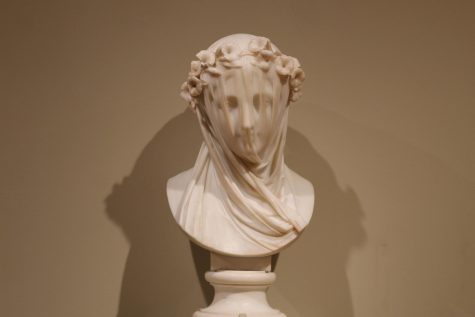
Once the students had finished looking at the Renaissance gallery, they had free reign of the MIA. With three floors densely packed with art from all time periods and many different cultures, it’s impossible to look through everything in one trip. Winget’s favorite pieces are from the “Chinese or Asian art [exhibits] because students in the US really don’t learn a lot about Asia at all, historically or culturally. It’s such a long-lived civilization like Egypt but we won’t get to cover a lot of China this year due to [this school year’s] focus on London, Paris, and Rome.”
Many of the students were drawn to the marble bust Veiled Lady by Raffaelo Monti for its incredibly lifelike veil. However, the most popular sites were the mock rooms from places like England during the Tudor era and paintings from the personal collection of the Minnesotan railroad tycoon, James J. Hill.

With a new vision of art from Minnesota and elsewhere, the Humanities students experienced what art was like in a museum setting, and not just as pictures in a slideshow in class. Additionally, as the exclusive exhibit was close to home at the MIA, they didn’t have to travel to European art history hubs in order to see and appreciate the Renaissance. With the help of their teachers, the Humanities class left the MIA with newfound knowledge to appreciate and cherish art in all its forms.

Salutations! I am Grace Miller, the editor-in-chief for the Lantern. I am heavily involved in FFA, speech, and my job as a barista, but my true calling...
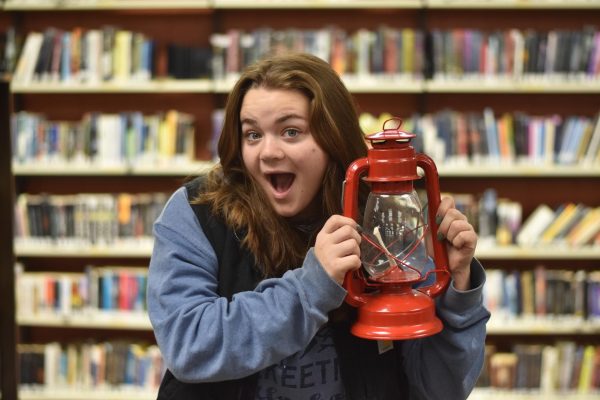
Sara is a senior editor for The Lantern. This is her sixth year writing. Sara enjoys a myriad of activities including taking ill-timed naps and raiding...


